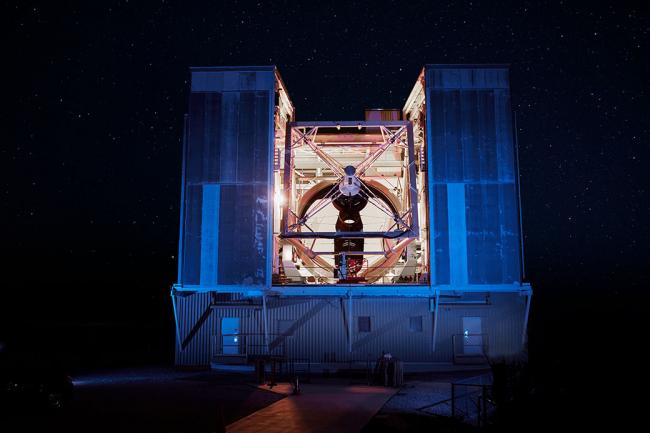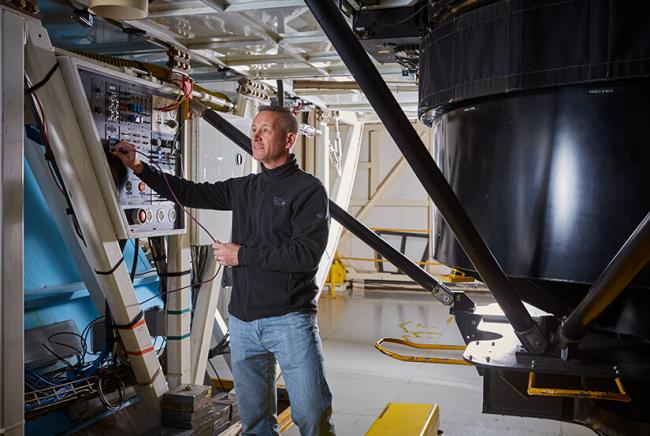MMT Observatory
The MMT Observatory is the premier visible-light and infrared telescope jointly managed by the Smithsonian Astrophysical Observatory, part of the Center for Astrophysics | Harvard & Smithsonian, and the University of Arizona. Located at the Fred Lawrence Whipple Observatory (FLWO) in southern Arizona, this 6.5-meter (21 foot) telescope is used to study objects across the field of astronomy, from the Solar System to distant galaxies. The MMT has provided a testbed for new telescope technologies developed by scientists and engineers at the CfA and the University of Arizona.

The 6.5-meter MMT Observatory is located at the Fred Lawrence Whipple Observatory in southern Arizona.
The Telescope and the Science
The MMT Observatory was originally built as the Multi-Mirror Telescope in 1979, with six mirrors acting together to focus light from astronomical sources. This design was chosen in part because large mirrors were more difficult and expensive to fabricate then, and because it was easier to transport smaller mirrors to the top of Mt. Hopkins, a 2600-meter (8600 foot) tall mountain in the Santa Rita Mountains of southern Arizona. In subsequent decades, engineers improved mirror-making techniques to lower both weight and cost, allowing the smaller mirrors to be replaced by a single 6.5-meter mirror in 2000. The single mirror improved the field of view — the amount of sky viewable by the telescope — by more than 300 times. The telescope retains the MMT name, though the acronym isn’t generally used anymore.
From the beginning, the MMT has been used to test new technologies and innovations for astronomy. While many large telescopes in 1979 were built to track astronomical objects along just one axis for engineering simplicity, the MMT was constructed to be track objects along both axes. The modern telescope is equipped with “adaptive optics”: a flexible secondary mirror which creates extremely sharp astronomical images by correcting for distortions created by Earth’s atmosphere.
Scientists and engineers at the CfA developed a suite of instruments both to create images and to analyze the spectrum of light from astronomical sources. These include Megacam, a liquid nitrogen-cooled array of 36 charge-coupled device (CCD) detectors, the same basic technology used in digital cameras. Each of the 36 CCDs capture images 2048 x 4608 pixels in size, making Megacam one of the largest astronomical cameras in use. Other instruments include the SAO Widefield InfraRed Camera (SWIRC) designed for taking infrared images, along with the MMT and Magellan Infrared Spectrograph (MMIRS), Binospec, Hectospec, and Hectochelle spectrographs, which are capable of analyzing the spectrum from multiple astronomical objects at once.
These instruments make the MMT a powerful general-purpose optical and infrared observatory, useful for studying astronomical objects from the Solar System to distant galaxies. To list just a few, astronomers have used the MMT to identify systems for future gravitational wave observatories, follow up on exoplanet observations, analyze star-forming regions, and study the environment of supermassive black holes.

Dr. G. Grant Williams is Director of the MMT Observatory at the Fred Lawrence Whipple Observatory (FLWO) in southern Arizona.
Instruments
MMT:
Optical
Binospec - moderate dispersion multi-slit spectrograph and imager
Hectospec - moderate dispersion 300-fiber spectrograph
Hectochelle - high dispersion 240-fiber echelle spectrograph
Blue Channel - moderate dispersion single-slit spectrograph
Red Channel - moderate dispersion single-slit spectrograph
MMT Cam - small field-of-view imager
SPOL - imaging spectropolarimeter
Near-IR
MMIRS - multi-slit spectrograph and imager
ARIES - adaptive optics imager and spectrograph
MMT-Pol - imaging polarimeter
- Why do we need an extremely large telescope like the Giant Magellan Telescope?
- How do stars and planets form and evolve?
- What happened in the early universe?
- What do black holes look like?
- Why do galaxies differ so much in size, shape, composition and activity?
- Machine Learning
- Atomic & Molecular Data
- Gravitational Waves
- Masers
- Medical Applications
- Planetary Geology
- Space Weather
- Solar and Stellar Atmospheres
- Cosmic Microwave Background
- Cosmology
- Stellar Astronomy
- The Milky Way Galaxy
- Extragalactic Astronomy
- Planetary Systems
- Instrumentation
Related News
AI Helps Astronomers Discover a New Type of Supernova
Extreme Weight Loss: Star Sheds Unexpected Amounts of Mass Just Before Going Supernova
Tracing the Origins of Rare, Cosmic Explosions
The Tilt in our Stars: The Shape of the Milky Way's Halo of Stars is Realized
Our Galaxy’s Most Recent Major Collision
The Host Galaxy of a Fast Radio Burst
Creating Ultra-Diffuse Galaxies
Cold Molecular Clouds as Cosmic Ray Detectors
Projects
AstroAI
DASCH (Digital Access to a Sky Century @ Harvard)
For that reason, the DASCH (Digital Access to a Sky Century @ Harvard) team are working to digitize the plates for digital storage and analysis. The process can also lead to new discoveries in old images, particularly of events that change over time, such as variable stars, novas, or black hole flares.
Sensing the Dynamic Universe
SDU Website